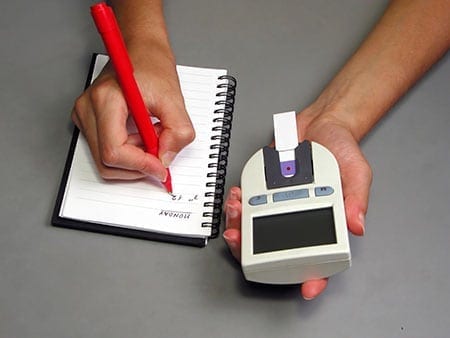The A1C test is a blood test used to diagnose diabetes and see how well your diabetes self-management plan is working. When your numbers get high, it increases your risk of developing diabetes related complications such as neuropathy and kidney disease. Discover 4 simple ways to get your A1C down.
- The first way to get your A1C down is to educate yourself about the test and proper diabetes self-management. The A1C blood test is accurate and does not require fasting. If your A1C is between 5.7 and 6.4 percent, you have pre-diabetes. This gives you time to get the number down and possibility avoid developing diabetes, if you work closely with a dedicated health care team. When the number is 6.5 percent or above, you have diabetes. It is important to keep your A1C levels below 7 percent to reduce diabetes complications. Work with your diabetes health care team to develop an effective self-management plan. Talk to your doctor periodically to find out if your medications should be changed. Keep your medications organized and take them in accordance with the schedule provided by your doctor. Monitor your blood sugar regularly and keep track of the results to share with your doctor during regular exams. Look into ordering an A1C home testing kit so you can check your levels to stay on track. Share the results with your health care team. Studies have shown working with a diabetes nurse educator can help you lower your results. Ask questions, do research and take advantage of Smart Phone apps that can help you stick to your diabetes self-management plan.
- Exercise also helps lower your A1C levels. Fit in at least a half hour of exercise and movement each day. This may include aerobics, stretching or weight resistance training. Try to make exercise fun and convenient to fit it into your schedule. Take a Pilates or yoga class. Try paddle boarding or surfing. Go bowling or play golf. Find ways to fit exercise into your most hectic days. Park further from the store when you do errands. Rotate your arms and do leg lifts at your desk. Walk around when you talk on the phone instead of sitting. Play with your children and move around when you attend their sporting events. Any movement helps.
- Healthy eating is another way to lower your A1C. Try to avoid packaged, fast and processed foods. Eat as many whole foods as possible. Try raw foods. Usually these are found around the outer aisles of the grocery store. If you buy packaged foods, read the labels carefully. Try to minimize your intake of added sugar, salt, saturated fats and high levels of carbohydrates. Eat fresh fruits and vegetables. If you choose canned or frozen ones, make sure they are not packed in sugary juices or fatty sauces. Select plain versions when possible and use fresh spices to add flavor. Choose low-fat dairy products and lean meat and fish. Be aware of portion sizes to avoid overeating. Consider weighing your foods or using portion plates to determine how much to eat. Stay on a regular eating schedule to avoid blood sugar spikes.
- Develop a plan for success. Create reasonable weight loss goals and adopt ways to achieve them. Know what works for you and what doesn’t. If you don’t get to the gym, find another way to exercise. Quit bad habits such as smoking, drinking too much alcohol and consuming sugary beverages. Find healthy ways to cope with stress, such as deep breathing, meditation, yoga or Tai chi classes. Get enough sleep each night to feel more energized, reduce stress and maintain a healthy weight.
A few simple lifestyle changes can help get your A1C down. Make a plan, exercise regularly, eat healthy foods and work with your health care team to make changes as needed. When you are well-informed, it helps you make better choices to gain control over your health.







Leave A Comment